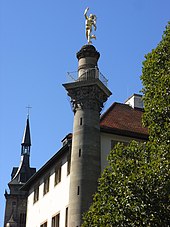Schillerplatz (Stuttgart)
The Schiller Square is a square in the center of Stuttgart . It was created in its current form in honor of Friedrich Schiller . It is surrounded in the southwest by the collegiate church , the fruit box , the Prinzenbau (today the seat of the Ministry of Justice ) and the old chancellery and finally the old castle .
A weekly market takes place twice a week on Schillerplatz . Many events that primarily take place on the Stuttgart market square will be extended to Schillerplatz, such as the Stuttgart Christmas market or the Stuttgart wine village. There is also an underground car park under Schillerplatz.
Finds around Schillerplatz show it as the historical core of Stuttgart's old town. Traces of settlement from the 8th century were found under the old castle adjoining to the south-east, burials dating from the 7th / 8th century under the collegiate church. Century. Most of the archaeological findings under Schillerplatz were, however, largely undocumented destroyed when the underground car park was built in 1973.
Earlier names
The Schillerplatz was officially called "Alter Schloßplatz" until 1934, but the name Schillerplatz had been in use for a long time at that time. The name "Alter Schloßplatz", on the other hand, came up in the 18th century when Stuttgart's Schloßplatz was created with the construction of the New Palace (1746–1806) . Before that, today's Schillerplatz was called "Schloßplatz".
Schiller Monument on Schillerplatz
In the middle of the paved square is the Schiller monument, erected in 1839 by the Dane Bertel Thorvaldsen . It was the first Schiller monument in Germany. A drawing by Schiller by Johann Christian Reinhart , which was made in 1787 and is now lost, served as a template . The fairy tale The Old Church Bell , written by Thorwaldsen's compatriot Hans Christian Andersen , is about its creation .
Another Schiller monument is located in front of the Great House of the Württemberg State Theater in Stuttgart , a work by the Stuttgart sculptor Adolf von Donndorf from 1913, see Schiller Monument (Stuttgart 1913) .
history
The first permanent house in Stuttgart, the Stuthaus, was next to the collegiate church. It is therefore reasonable to assume that the area of today's Schillerplatz was part of the Stutengarten stud farm around the year 1000. Since the 12th century the area was probably settlement area, from the 13th century stone houses like the Fruchtkasten were built. In the middle of the 14th century the Dürnitz building of the old castle was built. In 1542 the construction of the office was completed. A few years later the arcade wing of the old castle was built and the area up to the office was designed as a moat. In 1594 Duke Friedrich I commissioned the master builder Heinrich Schickhardt to create a representative Renaissance square in the area of today's Schillerplatz . For this purpose, the existing houses were bought up and demolished until shortly before 1600. The resulting space was paved and called the Schloss- und Kanzleiplatz. Since then, the square has its current dimensions.
In 1605, construction work began on the ambassador's house, today's Prinzenbau . This building was completed in 1677. In 1715 the Prinzenbau behind the old chancellery was extended to the Planie. This is where the registry sheet was created . On the south side of the square, between the castle and the collegiate church, the first Stuttgart coffee house opened in 1712 , from which the inn "König von England" was created in 1798. A few years earlier, between 1775 and 1777, the moat was filled in. This finally gave the square its current shape.
In 1934 the old Schlossplatz was officially renamed Schillerplatz. In 1944/45 all the buildings around Schillerplatz burned down. Except for the "King of England" they were rebuilt and preserved in their external form. In 1972/1973 an underground car park was built under Schillerplatz.
Old firm
On the building of the old chancellery there is a round, slender, high tower from 1598. The remarkable figure on this column - a "youth made of gold" - was made by Ludwig von Hofer (1862), executed by Wilhelm Pelargus , and represents a Mercurius .
See Old Chancellery , Merkursäule (Stuttgart) .
literature
- On the old castle square. The Schiller Monument . In: Eugen Dolmetsch: From Stuttgart's Past Days (second volume of "Pictures from Old Stuttgart"). Self-experienced and retold. Stuttgart 1931, pages 84-91.
- The Schiller Monument in Stuttgart. In: Bernhard Gerlach: The literary significance of the Hartmann-Reinbeckschen house in Stuttgart, 1779 - 1849. Münster 1910, page 69-73.
- André Lambert; Eduard Stahl: Old Stuttgart Architecture. Stuttgart [1906], plate 41 (Kanzleibogenbrunnen).
- Harald Schukraft : Stuttgart street history (s) . Silberburg-Verlag , ISBN 3-925344-05-5 , pages 8-14.
Web links
Individual evidence
- ↑ Hartmut Schäfer: The beginnings of Stuttgart. From the mare garden to the Württemberg residence, Stuttgart 2012, pp. 40–45
- ↑ Hartmut Schäfer: The beginnings of Stuttgart. From the mare garden to the Württemberg residence, Stuttgart 2012, p. 122
- ↑ Markus Bertsch u. a .: Johann Christian Reinhart. A German landscape painter in Rome. Catalog book for the exhibition in Hamburg, Hamburger Kunsthalle, 2012/2013 and in Munich, Neue Pinakothek, 2013 . Ed .: Herbert W. Rott, Andreas Stolzenburg. Hirmer, Munich 2012, ISBN 978-3-7774-8021-3 , pp. 39 .
Coordinates: 48 ° 46 '37.76 " N , 9 ° 10' 42.48" O




